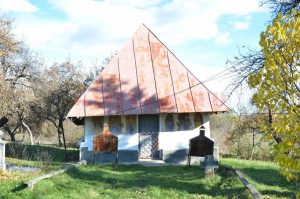

The statue dedicated to the prince Constantin Brâncoveanu was dedicated on the date of the 26th of May 2011, on the occasion of the High school Days from Baia de Aramă.
Constantin Brâncoveanu (born at 1654 – deceased on the 15th/26th of August 1714) was the prince of Wallachia between the years 1688 and 1714, having one of the longest reigns in the history of the Romanian principalities. Great aristocrat, nephew from the sister part of the prince Șerban Cantacuzino, he inherited and accumulated a considerable fortuned, which consisted of immobile properties, mobile goods and amounts of money deposited abroad. During the period of his reign, Wallachia met a long period of peace, of cultural glooming and of development of the spiritual life, he left a great number of religious foundations and an eclectic architectural style which bears his name.
In the external politics Brâncoveanu acted moderate, avoiding to be positioned decisively in the imperial camp, which in a significant burst recovered Hungary and Transylvania from the Ottomans. He bought the benevolence of Turks, paying regularly the dues and depositing huge amounts of the Sultan and of the clerks from Constantinople, which gave it the names of „altın bey” (in Romania the prince of the gold). Holding agents and spies in all around Europe, the Muntean prince was informed about the news throughout the entire continent and he simultaneously informed the rival camps.
As for Moldavia is concerned, the Muntean prince intervened repeatedly in the question of the reign, while in Transylvania he exercised an important cultural influence, by spreading the prints and the foundation of the religious establishments.
Although he managed to be confirmed as a prince in the reign (1699) and re-confirmed by the new sultan in 1703, the prince permanently worked in order to ensure abroad a refuge from the Turks, being conscious about the precariousness of his situation. Finally, he was taken by surprise, being relegated in April 1714 and taken with his entire family at Constantinople, where he was tortured in order to abandon to the Turks his entire fortune. Constantin Brâncoveanu was executed on the 15th of August 1714, together with his four sons (Constantin, Ștefan, Radu and Matei) and with the Councillor Ianache Văcărescu; at this catastrophe there also contributed the intrigues of the Cantacuzino family. For the manner in which they died, all of them are worshipped by the Romanian Orthodox Church, which canonized them under the name of the Saints Forty Martyrs Brâncoveni in 1992.
The bloodline of the prince was ensured by the children of his daughters and of Constantin the IInd, around the middle of the XIXth century being able to be counted over two hundred living direct descendants.
In 2014, on the occasion of the celebration of three hundred years from the martyr, the remains of the prince have been dig out and placed in a tabernacle, which is exhibited at the Saint Gheorghe the New Church from Bucharest.


